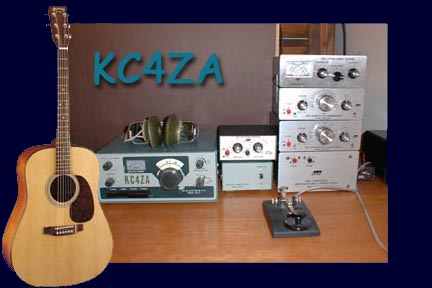

I received my Novice class license, KN2GVL, in 1955 at the age of 12 and soon discovered the challenges of operating low power from an apartment building in the Bronx,New York City. Challenge is perhaps a euphemistic way of putting it. I managed only a handful of contacts on the crowded 80 meter Novice band using a modified WWII surplus BC-454 receiver and a Handbook 6AG7 home-built transmitter. The transmitter fed a random wire hung (dangling style) from our sixth story apartment. Inexperience obviously played a big role in my less than stellar entry into Ham radio. Although I read as much as could find, I had not actually listened to many QSOs before I started pounding the key. The best part of my Novice experience was building the 6AG7 rig from scratch. I read every page of the Handbook many times over. Little did I realize that one book would serve me well for many years to come. This was also my first experience with hole punches, metal files, soldering, tubes and high voltages, shocks and RF burns.
Looking for more adventure, I upgraded my Novice license to Technician, and dropped the "N" to became K2GVL. I began operating on 6 meters after building a Heathkit Sixer (Benton Harbor Lunchbox). The Sixer was lots of fun, but eventually, the ads in QST got my eyeballs rolling and after some cajoling, my parents bought me a Gonset Communicator III (Gooney Box). Six meters offered lots of opportunity to experiment with antennas, and I tried about everything I could put on the roof of our apartment building: dipoles, halos, ground planes, and small beams which I made from TV antenna parts and stuff I would find in the surplus parts bins on radio-row near the Battery. In the late fifties, TVI on Six meters was a serious problem. I bought filters and installed them on my neighbors TV sets and fixed a lot of frayed antenna wiring, but eventually I had to settle into operating late at night, early in the morning or during non-prime time hours to keep TVI problems manageable. My foray into microwaves was short and unspectacular. Using a surplus 726A Klystron, I built a polaplexer from an article in QST but I abandoned the idea of doing any serious communications when I couldn't find anyone willing to build a second one. The polaplexer did work though. I was able to hear the signal as it bounced back from the blades of a whirling electric fan. So my microwave record remains at something under 50 feet. I never sent myself a QSL card so it's my word against my word.
After graduating from CCNY in early 1964, Ham radio took a back seat where it would remain for many years. I started my Army career and got married. We moved quite a bit at first and my interest in Ham radio waned. I kept dabbling in electronics, building stuff mainly from electronics magazines that at least seemed at the first reading to be a great idea. In 1967 our daughter was born followed by our son in 1971. The following year I completed an MS in Nuclear Engineering at NC State and we moved to the northern Virginia for a utilization assignment at the Pentagon. At the Pentagon, I was introduced to a roomful of machinery known as an IBM-360 and after a short introduction wading through some boring and largely incomprehensible manuals, I started to program the thing. I was actually assigned as a strategic analyst, but I quickly learned in that assignment if you couldn't program a computer to fill up reams of paper with tables then you got no data to analyze. That also was in the days of punched card machines, card sorters, batch processing, and of course plenty of free chad, and ketchup. Batch processing generally meant that if the first job failed, so did all the others behind it. The card sorters helped put a deck back together after the box of punched cards was unceremoniously dropped. The punched card machines created chad. The chad piled up on the floor and ketchup sometimes hardened on a tape making it somewhat less than unreadable. I hated hamburgers with ketchup for some time.
My next assignment to Washington put me on the Army staff and one day I decided to visit the Pentagon Amateur Radio Club K4AF. It didn't take long for the bug to bite again once I heard the chatter coming from the station's Drake receiver. I upgraded my license to Advanced class, received call sign KA4JBA, and began operation on 1 June 1979. On 20 March 1980, I joined the QRP Amateur Radio Club International (QRP ARCI) as member number 4568. A spot of good luck in April and May 1980 netted two 1000 Mile-Per-Watt Certificates for contacts with G3PIM and G3RDQ. On March 27, 1981, eager to shorten my call, I exchanged my 2x3 call for KC4ZA (for the curious that's a saving of one dit and one dah). Since returning to the air, I have operated almost exclusively QRP CW. My rigs include a Heathkit HW-8 (kit-built) and MFJ transceivers for 40 meters and 30 meters. Although, I'm no longer a cliff dweller, antenna and space restrictions still force me to try compromise antenna solutions such as loaded verticals, window mounted portable antennas, short dipoles, and random wires. I have a QRO rig, an IC-736, but I actually use it mostly for casual listening and decoding various types of signals using Cris Smolinkski's excellent MultiMode software for the Mac http://www.blackcatsystems.com . Occasionally I fire up the rig, but the ability of QRP to communicate around the world on the power of a flashlight bulb still fascinates me.
73,
Alan Skerker, KC4ZA
Mailto: [email protected]< /a>